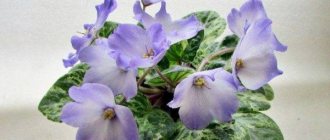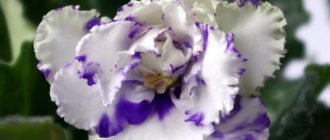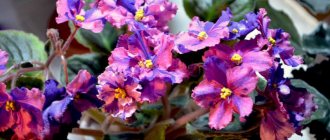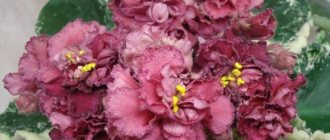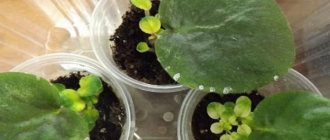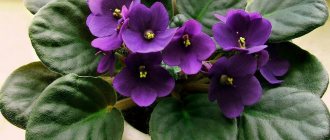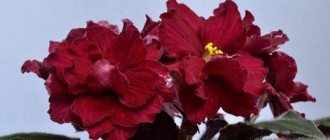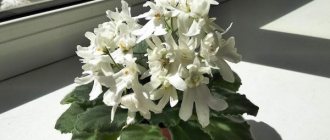Violet Winter Smiles, B. Makuni
The flowers are semi-double-double, light pink with wine-red strokes on the edges of the petals, behind which there is an elegant soft light green fringe, reminiscent of winter frost. The leaves are green with an olive tint, rounded, slightly elongated. Neat compact socket.
Properties
Name
- Original: Winter Smiles
- Transcription:
- Translation:
Registration
- Selection: B.Makuni
- Year:
Socket
- Socket type: standard
Flower
- Flower size, up to: 5.5 cm
- Flower shape: star
- Terry size: semi-double, terry
- Main color: pink
- Color type: plain
- Border: plain fringe
- Other features: brush strokes along the edges of the petals
Foliage
- foliage color: medium green
- foliage type: simple
- foliage shape: heart-shaped; quilted
- reverse side of sheet: pink
- leaf edge: jagged edge
- variegation: no
Story
The author of this variety is Boris Mikhailovich Makuni, an outstanding domestic breeder. He was born on September 29, 1930. In memory of him, September 29 is celebrated as Violet Day. He and his wife Tatyana Nikolaevna, an active assistant in his work, began breeding violets in 1962. Until the mid-90s, the Makuni family bred about 300 varieties of violets. Its varieties have become popular in our country, America, Europe, Japan and still live in collections and delight us with their uniqueness, beauty, ease of care and propagation. On June 4, 2002, Boris Mikhailovich died. The variety Winter Smiles is the calling card of violets of his selection. Collectors have been trying to preserve this variety unchanged for many years.
Conditions of detention and care
The concept of “keeping conditions” for the “Winter Smiles” violet includes the following factors:
- lighting;
- air temperature;
- air humidity;
- watering;
- pot size;
- the soil.
Let's take a closer look at each of these factors.
Lighting
Perhaps the most important rule for this variety of violets, as well as for others too, is maximum light, minimum sun.
Violets “cannot tolerate” sunlight falling on their terry leaves: they immediately begin to signal discomfort, showing dried leaves and wilted flowers.
Therefore, to locate a pot with a plant, you need to choose a cool, bright place, in which there is no room for sunlight. How to choose the right place? In fact, by some miracle, the violet itself is able to tell where it is most comfortable in terms of lighting.
Important! When there is little light, its leaves begin to go down and bend over the edge of the pot, and when, on the contrary, there is enough light, they rise up and stand at attention.
Light plays an important role in the life of the violet. Since it blooms often and for a long time, it needs to receive at least 10 hours of light per day. If there is not enough light, then, alas, you will not be able to wait for abundant, long-lasting flowering.
However, different varieties of violets react differently to light. Those with pale green leaves can get by with a small amount, but violets with dark green leaves need well-lit conditions. You can stock up on fluorescent lamps - Saintpaulias love the light from these lamps.
Air temperature
The most moderate temperature for keeping violets is 20-22 degrees. This is a rather heat-loving plant that categorically does not tolerate cold and temperature changes, as well as heat.
At the same time, the room must be regularly ventilated; You can even resort to using an air conditioner or fan.
However, you should be vigilant here: drafts can cause extremely unsightly yellow spots to appear on the leaves of Saintpaulia, and hypothermia will lead to rotting of the root system.
Humidity
>The violet variety “Winter Smiles” needs high air humidity - at least 50%. Not everyone has a special air humidifier, but this problem is easily solved: you can simply place containers of water next to the plant. But it’s worth keeping an eye on the humidity, because if it is more than 70%, there is a risk of fungal diseases developing on the cuttings and leaves.
Watering
You can water the violet with ordinary tap water, but first it is better to let it sit for a day or so and then boil it.
Water for irrigation should be warm, especially if it is winter outside and the plant itself is on the windowsill. When watering, water should be poured onto the plant itself, and not into the root.
Attention! If there is too much water, remove it from the pan. The frequency of watering depends on the degree of dryness of the soil - this can be easily determined by touch.
Pot
The violet of the “Winter Smiles” variety will be most comfortable in a small plastic pot that matches its size.
The soil
The soil for the designated violet variety should allow air to pass through well and retain moisture. To do this, you should add a mineral of natural origin. Charcoal is also a good solution. Good drainage is also important for violets. As for the pH level in the soil, a neutral level is required.
We think
Peculiarities
Delicate pink flowers, quite large up to 5.5 cm, with a light green fringe and variable wine-red strokes along the edges of the petals, are located on strong peduncles with 3-5 flowers on each. Flowering is long and frequent. In cool conditions, the green fringe is brighter; in hot conditions, it turns white.
Over the many years of existence of this variety, some changes have occurred with the flowers. From photographs posted on the Internet, one can see simple flowers, bright pink, not with strokes of wine red, but with a border of the same color, with a heavily ruffled green ruffle. Such deviations are sports that do not correspond to the variety created by the author.
The rosette is of medium size for standards 20-23 cm, depending on the conditions of detention it can be larger. The rosette is smooth and flat under all conditions. The leaves are heavily quilted with a serrated edge. The variety feels equally good both in daylight and on a shelf; both with top watering and wick watering.
Propagates well by cuttings, produces from 2 to 5 children. The first flowers can be seen 7-9 months after rooting the cuttings.
A wonderful, very beautiful variety with delicate flowers. There are no problems in growing it, it can be recommended to novice collectors.
When buying a cutting, you need to pay attention to how the mother rosette blooms.
There are goldfish here
The obsession with which Elena Lebetskaya works on new varieties inspires respect: about 50 crosses and 30-40 sowings per year. But from each crop, only one or two, or sometimes three or four, seedlings become varieties. Elena’s result is 20-25 varieties a year! But such work makes it possible to obtain original varieties that are different from each other. Today it is very difficult to catch something new; an unusual, special violet is like a goldfish. Elena has goldfish. Her personal achievement is a curly “pansy” with a green ruffle and super-abundant flowering. Before her, breeders treated this classic flower form inattentively, even condescendingly - it was too simple. But Lena showed us “LE-Yesenia”, “LE-Beautiful Creole”, “LE-Pannochka”, “LE-Witch Lake”, and everyone gasped. And her 2012 varieties 'LE-Flamenco', 'LE-Flirt', 'LE-River Lily' are already a real bomb!
LE-Cleopatra
In general, the variety of Lebetskaya varieties is amazing: double flowers with edging ('LE-Magenta', 'LE-Amelie', variety 2013 'LE-Elf Garden'), large-flowered fantasy varieties (2013 variety with the working name 'LE-Cleopatra'), delicate bells ('LE-River Lily'), varieties with fingering color ('LE-Sulamith') and unique colors ('LE-River Nymph', 'LE-Grey-haired Earl').
Photo
Violet Winter Smiles, B. Makuni, photo by T. Lysikova:
The flowers are just beginning to bloom:
First flowering:
